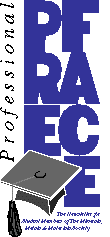 This story appears in The Minerals, Metals & Materials Society's student newsletter
Professional Preface, vol. 2, no. 4, p. 2.
This story appears in The Minerals, Metals & Materials Society's student newsletter
Professional Preface, vol. 2, no. 4, p. 2.
So you have achieved a professional milestone--you have completed an R&D program that you and your supervisor consider worthy of dissemination to the community at a professional meeting. Elation and fear! You will become instantly famous, but you will have to talk to a hostile group looking to shoot you down in flames in front of your peers.
Your abstract, with a colleague and supervisor as coauthors, has been accepted for inclusion in a symposium. You are confident that your data are good and useful, but where to go from here? Your supervisor has experience and is there to help you--make use of this resource.
The first step in preparing your presentation is making a general outline of what you plan to present. Don't give the audience too many details--this is not a paper. You are trying to cover only the key points without overloading (boring) the audience. The key points of an outline are the introduction (key points that will be made), acknowledgements, background, results (key points in more detail), discussion, and conclusions (key points that have been made).
After creating your general outline, put some meat on the bones. Add specifics to your work. I like to add a little humor to my presentations. Remember half of the audience is dreaming of past or future pleasant experiences. The humor gets everyone's attention, but it may not be appropriate for your first presentation. Do what is comfortable for you.
Should you use slides or overheads? In the United States, slides are generally used at professional meetings; in other parts of the world, there is a movement to overheads (a pain to carry for a long presentation). Keep in mind that even with simple visual aids, one slide per minute is a maximum. The golden rule of visual aids is the KISS rule--Keep it Simple, Stupid! The first slide/overhead should show the title, authors' names, and affiliations. You might consider a backdrop of your building or a local scene of interest. Your introductory slide/overhead should be followed by a brief acknowledgement slide. Who contributed but isn't an author? Slides/overheads should not be taken directly from your paper; they should be simplified versions. Use color, and use large letters. If you can't read the contents of your slide easily in 20 seconds, it's too complicated--redo. Don't just read your slide/overhead; embellish on it.
Remember to leave time for questions, generally five minutes for a presentation of up to 30 minutes duration. You may have a strong desire to talk for the full amount of time you have been allocated--resist this temptation. The question/answer session is often the most valuable and interesting part of a presentation.
Now you have a simple, concise copy of your presentation. Review it with your colleagues and supervisor; iterate and modify. There is no excuse for sloppy visual aids; have them made professionally.
Go through a couple of practice runs. One technique we use at the University of Idaho is to videotape an early dry run and allow a self-critique. Review yourself enough times to ensure that your presentation is smooth and clearly delivered (good English is a must). I suggest no reading from notes or cue cards. Let each slide key the words you want to say.
You are now ready to attend the conference with supreme confidence. Here's how it goes:
You review your presentation a few times on the plane and in your hotel room. When the day of your presentation arrives, you attend the author's coffee and meet your chair. Although you were apprehensive of meeting such an accomplished individual, the chair is friendly and says she is there to help you. You are reminded that the chair is in charge and will start your presentation exactly on time and will curtail your presentation if you start to run too far into the question-and-answer session. It is unlikely that your time slot will be changed or shortened in a multisession conference, but it's possible--be flexible.
The time of your presentation is here. You are no longer in the audience but in front of them. They (there are hundreds of "them," and they have no faces) are going to subject you to a fate worse than death. You have given your slides to the projectionist (perhaps a student monitor such as yourself a year before) in plenty of time or you have informed the chair that you plan to use overheads.
The chair introduces you. You stumble up to the podium, have a microphone attached, and launch into your presentation. Your mouth is dry but you manage to get the words out. Don't talk to the screen; look at the audience, and, if possible, make eye contact. Use the pointer only as necessary and don't waggle it.
You somehow get through the presentation, with even a little confidence as you move into your concluding slide/overhead. Applause! Maybe the audience isn't entirely hostile.
The chair solicits questions. The first question is trivial and easy; you answer with confidence. The second question is easier; it dawns on you that maybe you know more about this subject than the faces. The questioning finishes without problem.
Later, people meet you in the corridor and compliment you on your presentation and express interest in your work. You realize "I did good," and you are on the way to becoming famous.
The flipside--if you don't have anything worthwhile to say or don't prepare adequately, stay home. There are too many mediocre/bad presentations.
--F.H. (Sam) Froes
| Search | Professional Preface Home Page | Student Members Page | About TMS | TMS OnLine |
|---|